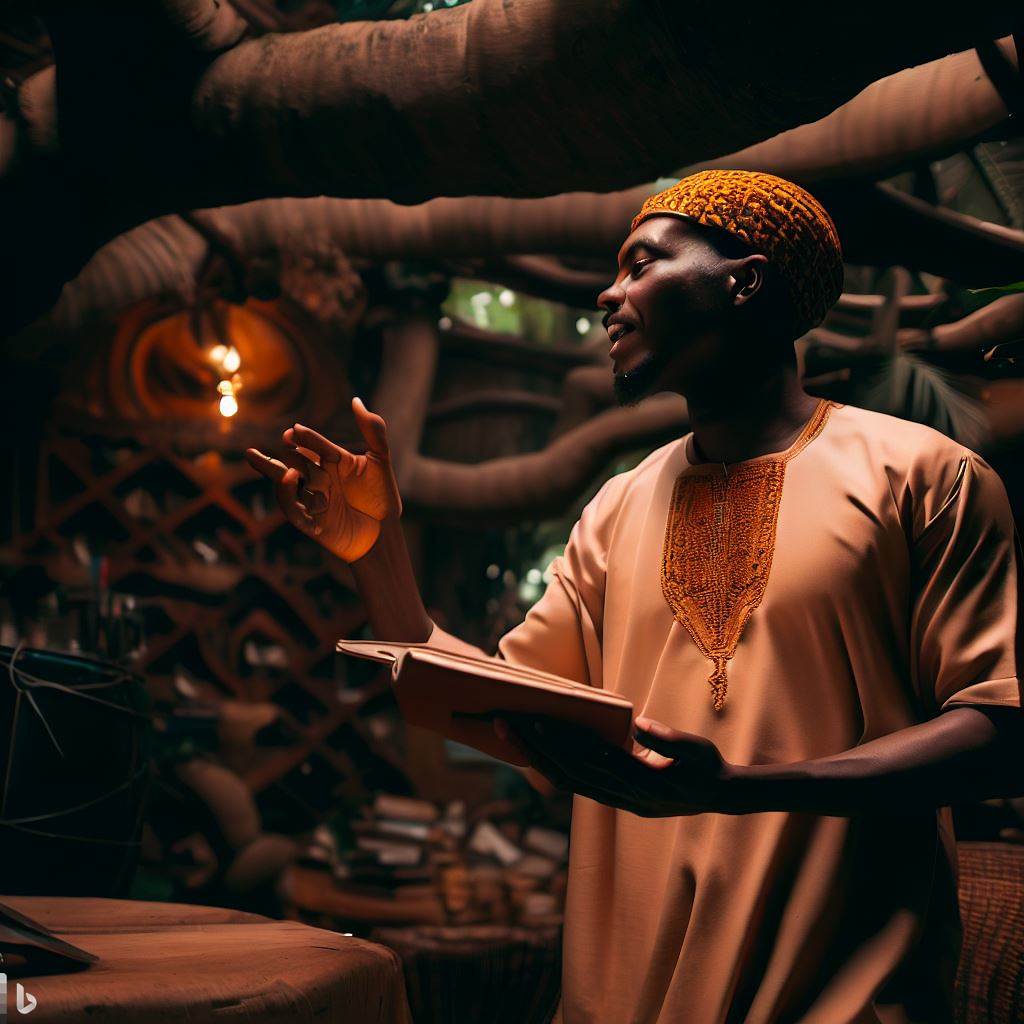Introduction
Exploring the connection between design and tourism in Nigeria.
Design plays a vital role in attracting and captivating tourists visiting Nigeria.
The country’s unique cultural heritage is showcased through various designs, such as architecture, interior decor, and traditional crafts.
These designs create a sense of authenticity, promoting cultural tourism in Nigeria.
Furthermore, well-designed tourism infrastructure, including hotels, resorts, and tourist attractions, enhances the overall visitor experience.
Thoughtful design elements contribute to comfort, convenience, and aesthetics, making tourists more likely to return and recommend Nigeria as a destination.
The connection between design and tourism also has significant economic implications.
A well-designed tourism sector can attract international visitors, increasing revenue through tourism expenditure.
It can also promote local artisans and craftsmen, boosting the local economy and creating employment opportunities in design-related industries.
In this blog section, we will delve deeper into the relationship between design and tourism in Nigeria.
We will explore how design influences the perception of Nigeria as a tourist destination and examine the economic benefits it brings.
By understanding this connection, we can better appreciate the role of design in fostering sustainable tourism growth in Nigeria.
In general, design plays a crucial role in shaping the tourism industry in Nigeria, impacting both visitor experiences and economic growth.
By exploring this connection, we can gain insights into how to leverage design to further develop and promote Nigeria as a desirable tourism destination.
Stay tuned for the upcoming sections where we will examine specific examples and case studies.
The Role of Design in Tourism
A. Definition of design in the context of tourism
- Design in tourism refers to the intentional creation of sensory and aesthetic experiences for visitors.
- It involves planning and arranging elements to enhance the overall appeal and functionality of tourist destinations.
- Design encompasses architectural structures, public spaces, landscapes, interior décor, signage, and wayfinding systems.
- Its purpose is to create memorable and immersive experiences that resonate with tourists.
B. Impact of design on tourists’ experiences
- Effective design in tourism enhances the overall satisfaction and enjoyment of tourists.
- Thoughtful design elements can evoke emotions, create a sense of place, and foster a connection with the destination.
- Design influences tourists’ perception of a destination, shaping their memories and desire to return.
- Well-designed spaces and amenities offer convenience, comfort, and accessibility to tourists.
C. Examples of well-designed tourist destinations worldwide
- The Guggenheim Museum in Bilbao, Spain, is an iconic architectural masterpiece that attracts tourists globally.
- The High Line in New York City provides a unique urban park experience, revitalizing an industrial area.
- The Gardens by the Bay in Singapore showcases innovative horticultural design, integrating technology and nature.
- The Sydney Opera House in Australia is a world-renowned landmark that combines remarkable architecture with cultural performances.
- The ancient city of Petra in Jordan features intricately carved rock architecture, preserving its archaeological heritage.
- The Tokyo Skytree in Japan offers panoramic views and architectural marvel, attracting tourists from all over the world.
Read: Unions for Writers in Nigeria: Role and Influence
Exploring Nigerian Design
A. Overview of traditional Nigerian design elements
- Nigerian design is rich in cultural diversity, incorporating elements from various ethnic groups.
- Traditional designs often feature vibrant colors, intricate patterns, and symbolic motifs.
- Geometric shapes and organic forms are commonly seen in Nigerian architecture and craftwork.
- Indigenous materials like wood, clay, and textiles play a significant role in Nigerian design.
B. Influence of Nigerian design on contemporary architecture and infrastructure
- Nigerian design elements have been incorporated into modern architecture, blending tradition with innovation.
- Contemporary buildings in Nigeria often feature traditional motifs, patterns, and materials.
- The use of Nigerian design in infrastructure projects reflects a sense of cultural identity and pride.
- Architects and designers utilize Nigerian design to create unique and visually striking spaces.
C. Integration of Nigerian design into tourism development
- Nigerian design is increasingly being utilized to enhance tourism offerings in the country.
- Traditional crafts, textiles, and artworks are promoted as souvenirs and cultural experiences for tourists.
- Design-focused events and festivals showcase Nigerian design talent and creativity.
- Boutique hotels and resorts incorporate Nigerian design elements to offer an authentic and immersive experience.
In short, Nigerian design encompasses a diverse range of traditional elements, which have influenced contemporary architecture and infrastructure.
The integration of Nigerian design into tourism development has become crucial for highlighting the country’s cultural heritage and attracting visitors.
By embracing and promoting Nigerian design, both locally and globally, Nigeria can celebrate its rich artistic traditions and contribute to sustainable tourism growth.
Read: Understanding Copyright Laws for Writers in Nigeria
Tourism Potential in Nigeria
A. Natural attractions and landmarks
Nigeria is blessed with a diverse range of natural attractions and landmarks that have the potential to attract tourists from all over the world.
One of the most famous natural attractions in the country is the Aso Rock, a large granite rock formation located in Abuja.
Surrounding the rock is the Aso Rock Presidential Villa, which serves as the official residence of the Nigerian president.
Another natural attraction in Nigeria is the Olumo Rock in Abeokuta, Ogun State.
This impressive rock formation has historical significance, as it served as a refuge during tribal wars in ancient times.
Tourists can climb to the top of the rock and enjoy breathtaking views of the city.
In addition to these rock formations, Nigeria also boasts stunning waterfalls.
One of the most well-known waterfalls is the Erin Ijesha Waterfall, also known as Olumirin Waterfall.
This seven-step waterfall is located in Osun State and offers visitors the opportunity to swim in its crystal-clear pools.
B. Cultural heritage sites
Nigeria is rich in cultural heritage sites, which reflect the country’s diverse ethnic groups and historical significance.
The Sukur Cultural Landscape in Adamawa State is one such site. It is a UNESCO World Heritage Site and is home to a well-preserved traditional settlement that dates back to the 17th century.
The Osun-Osogbo Sacred Grove in Osun State is another cultural heritage site worth exploring.
This sacred forest is dedicated to the river goddess Osun and is home to numerous shrines, statues, and artworks.
The annual Osun-Osogbo Festival attracts tourists from all over the world.
C. Emerging tourist destinations in Nigeria
Aside from the well-known attractions, Nigeria also has emerging tourist destinations that are gaining popularity among travelers.
One such destination is the Obudu Mountain Resort in Cross River State.
This hilltop resort offers breathtaking views of the surrounding mountains and valleys, and visitors can also enjoy activities like hiking, bird watching, and even skiing.
The Tarkwa Bay Beach in Lagos is another emerging tourist spot. Located on an island, this beach offers a tranquil escape from the bustling city.
Visitors can relax by the sandy shores or take part in water sports like jet skiing and banana boat rides.
Furthermore, the Lekki Conservation Centre in Lagos is becoming a popular destination for nature lovers.
This conservation center is home to various animal species and offers an opportunity to explore the vibrant ecosystem with a canopy walkway and nature trails.
In the end, Nigeria has immense tourism potential due to its natural attractions, cultural heritage sites, and emerging tourist destinations.
With continued investment in infrastructure and promotion, Nigeria can attract more tourists and boost its tourism industry.
Whether it’s the awe-inspiring rock formations, rich cultural heritage, or emerging destinations, Nigeria has much to offer for those seeking unique travel experiences.
Read: Profiles of Successful Social Workers in Nigeria
Designing Sustainable Tourism
A. Importance of sustainable design in tourism development
- Sustainable design is crucial in tourism development for preserving Nigeria’s natural and cultural heritage.
- It ensures that tourism activities are environmentally responsible, socially equitable, and economically viable.
- By incorporating sustainable design practices, tourism destinations can attract eco-conscious travelers and enhance their image.
- Moreover, sustainable design helps in minimizing the negative impacts of tourism on local communities and ecosystems.
- Overall, sustainable design is essential for creating a sustainable tourism industry in Nigeria.
B. Examples of sustainable design practices in Nigerian tourism
- Building eco-friendly accommodations that use renewable energy sources and promote energy efficiency.
- Designing tourist attractions in harmony with the surrounding environment, such as eco-parks and nature reserves.
- Using locally sourced materials and employing local workforce for construction and infrastructure development.
- Implementing waste management strategies, including recycling and waste reduction, in tourism facilities.
- Adopting sustainable transportation options like electric vehicles and promoting public transportation alternatives.
C. Benefits of sustainable tourism for Nigeria’s economy and environment
- Sustainable tourism contributes to economic growth by creating employment opportunities in the tourism sector.
- It encourages local entrepreneurship and stimulates the growth of small and medium-sized enterprises.
- The revenue generated from sustainable tourism can be reinvested in conservation efforts and infrastructure development.
- Preserving the environment through sustainable tourism helps protect Nigeria’s diverse ecosystems and biodiversity.
- Sustainable tourism also fosters cultural preservation and promotes pride in local heritage and traditions.
By prioritizing sustainable design in tourism development, Nigeria can harness the potential of its natural and cultural resources while preserving them for future generations.
Read: Women in Writing: Profiling Nigerian Female Authors

Uncover the Details: Nollywood’s Demand for Costume Designers: A Deep Dive
Challenges and Opportunities
A. Obstacles to integrating design in Nigerian tourism
- Lack of awareness among tourists about Nigerian design and its cultural significance.
- Inadequate knowledge and understanding of the value of design among tourism stakeholders.
- Insufficient funding and resources allocated to design initiatives within the tourism sector.
- Limited collaboration between designers and tourism professionals leading to a lack of innovation.
- Difficulty in promoting and marketing Nigerian design products and experiences to international tourists.
- Poor infrastructure and inadequate facilities that hinder the development of design-focused tourism projects.
- Inconsistent government policies and regulations that fail to support the integration of design in tourism.
- Low prioritization of design education and skills development within the tourism industry.
- Resistance to change and reluctance to embrace contemporary design practices within traditional tourism establishments.
- Perception of design as a luxury rather than a tool for enhancing the overall tourism experience.
B. Potential collaborations between designers and the tourism industry
- Partnerships between designers and tour operators to create curated design-focused tours.
- Collaborations between designers and hoteliers to incorporate local design elements into hotel interiors.
- Engagement of designers in the planning and development of tourism infrastructure to ensure design integration from the start.
- Cooperation between designers and local artisans to produce unique design products for the tourism market.
- Participation of designers in destination branding and marketing campaigns to showcase the distinct design identity of Nigeria.
- Inclusion of design exhibitions and showcases in major tourism events and conferences.
- Integration of design thinking and innovation workshops within tourism training programs.
- Formation of industry associations or networks to facilitate collaboration and knowledge sharing between designers and tourism professionals.
- Co-creation projects between designers and tourism stakeholders to develop design-led experiences.
- Utilization of digital platforms and social media to promote Nigerian design and reach wider audiences.
C. Strategies for overcoming challenges and seizing opportunities
- Enhance awareness through targeted marketing campaigns highlighting the cultural and economic value of Nigerian design.
- Educate tourism stakeholders about the role of design in enhancing visitor experiences and increasing competitiveness.
- Advocate for increased investment in design initiatives by showcasing the potential returns on investment.
- Establish a Design and Tourism Task Force that brings together government, designers, and tourism professionals to develop collaborative strategies.
- Improve design education and skills training programs to nurture a new generation of designers with tourism expertise.
- Create design guidelines and standards for the tourism industry to ensure quality and authenticity in design integration.
- Facilitate networking opportunities and knowledge exchange platforms for designers and tourism professionals.
- Encourage research and innovation in design by providing grants and incentives for design-led tourism projects.
- Streamline government policies and regulations to support the integration of design in the tourism sector.
- Promote sustainable design practices in tourism development to align with global trends and attract eco-conscious tourists.
Case Study: Successful Design and Tourism Collaboration in Nigeria
A. Overview of a specific case study
- In 2018, the Nigerian government launched a collaboration between designers and the tourism industry.
- The goal was to enhance the overall tourist experience and promote Nigerian design and culture.
- The collaboration focused on key tourist destinations such as Lagos, Abuja, and Calabar.
- Local designers worked closely with tourism officials to create immersive and culturally authentic experiences for visitors.
B. Highlights of the successful collaboration
- The collaboration led to the development of unique design installations in popular tourist spots.
- Local artisans were employed to create handcrafted souvenirs, supporting local economies.
- Tourists were able to engage with Nigerian culture through design workshops and exhibitions.
- Tourist spending on locally made products increased significantly.
- The collaboration received positive feedback from both tourists and locals, enhancing Nigeria’s reputation as a design destination.
C. Lessons learned and potential implications for future projects
- Strong partnerships between designers and tourism officials are essential for successful collaborations.
- Investing in local artisans and craftspeople can boost the economy and provide authentic experiences.
- Design workshops and exhibitions help to educate tourists about the local culture and heritage.
- Encouraging tourist spending on locally made products can support sustainable development.
- Similar collaborations can be replicated in other countries, fostering economic growth and cultural exchange.
The case study of the successful design and tourism collaboration in Nigeria demonstrates the immense potential of integrating design into the tourism industry.
By working together, designers and tourism officials can create unique experiences that showcase the local culture and boost the economy.
This collaboration highlights the importance of partnerships, investment in local artisans, and educating tourists about the cultural significance of design.
Going forward, similar projects can be implemented in other countries, contributing to sustainable development and fostering cross-cultural understanding.
Nigeria has set a precedent for successful design and tourism collaborations, and it is an inspiration for future projects around the world.
Conclusion
A. Recap of the key points discussed
The connection between design and tourism in Nigeria has been explored in this section.
B. Reinforcement of the importance of the connection between design and tourism in Nigeria
It has been established that design plays a crucial role in attracting tourists to Nigeria.
C. Closing thoughts and call to action
The integration of design and tourism can significantly enhance Nigeria’s tourism industry.
It is crucial for stakeholders to collaborate and invest in design-driven initiatives to attract more tourists and boost the country’s economy.
Let us embrace the power of design in promoting Nigeria as a must-visit travel destination.




